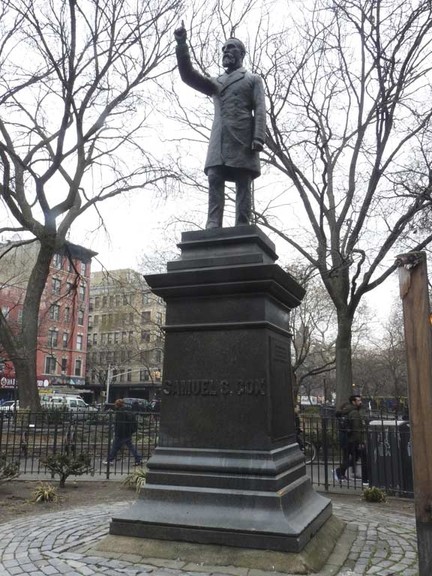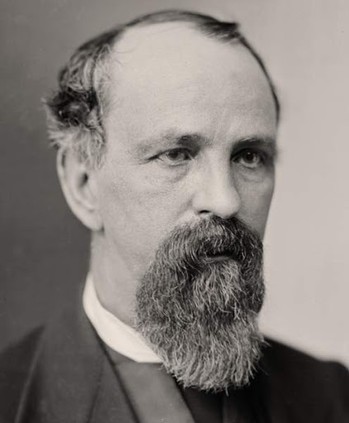Samuel Sullivan Cox Monument
Introduction
Text-to-speech Audio
Images
This monument to Samuel Sullivan Cox was funded by appreciative postal workers

Samuel Sullivan Cox (1824-1889)

The monument in its originally location
_pg184_COX_STATUE%2C_IN_ASTOR_PLACE.jpg)
Backstory and Context
Text-to-speech Audio
Samuel Sullivan Cox was born in Zanesville, Ohio on September 30, 1824. Named after his grandfather, Judge Samuel Sullivan, who served as state treasurer from 1820 to 1823, Cox briefly attended Ohio University in Athens before transferring to Brown University in Providence, Rhode Island. After graduating from Brown in 1846, he read law and was admitted to the bar. Cox began practicing law in his hometown of Zanesville in 1849, but a few years later became owner and editor of the (Columbus) Ohio Statesman, a Democratic newspaper. While working as editor of the periodical from 1853 to 1854, he published a captivating and eloquent description of a sunset, which led to him acquiring the nickname, “Sunset.”
In 1855, Cox commenced a lengthy career in public service. That year, he left the United States to accept an appointment as secretary of the legation at Lima, Peru. The following year, he returned to Ohio and successfully ran as a Democrat for a seat in the U.S. House of Representatives. Cox ultimately won reelection three times (1858, 1860, and 1862) and serve four full terms in Congress from March 1857 to March 1865. After losing his bid for reelection in 1864 and serving the remainder of his fourth term, he moved to New York City, where he resumed practicing law.
Cox’s desire to get back into the political arena, however, could not be suppressed and in 1868 he once again ran for Congress and won, this time representing a congressional district in New York. Two years later, he won reelection, but in 1872 lost his bid for a third term. Cox, however, did not remain on the sidelines long. At the end of April 1873, a vacancy opened up when Congressman James Brooks died. Cox ran to fill it and won. He occupied the seat for more than a decade until May 1885, when he resigned to accept an offer made by President Grover Cleveland to become U.S. ambassador to the Ottoman Empire. In October of the following year, Cox returned to the U.S. House of Representatives after winning election to fill the vacancy left by the resignation of Joseph Pulitzer. He occupied the seat until his death on September 10, 1889. His remains were buried in Green-Wood Cemetery in Brooklyn. Serving as honorary pallbearers at Cox’s funeral were former President Grover Cleveland and General William T. Sherman.
Cox’s two greatest political contributions pertained to the U.S. Life-Saving Service and the U.S. Postal Service. During his time in Congress, he was an ardent supporter of the U.S. Life-Saving Service. Absorbed by the U.S. Coast Guard in 1915, it patrolled America’s coastlines, helping to save the lives of shipwrecked sailors. Additionally, Cox helped pass legislation that gave U.S. Postal Service workers a pay raise, paid time off, and a forty-hour workweek. For his efforts on their behalf, he earned the moniker, the “letter-carriers’ friend.”
Shortly after Cox’s death, U.S. Postal Service employees embarked on a nationwide campaign to raise funds for the erection of a monument in his honor. Mail carriers from 188 cities across the United States donated a total of $10,000 to fund the monument, which was dedicated on July 4, 1891. Designed by sculptor Louise Lawson, the monument features an over-life-sized bronze statue of Cox standing on a granite pedestal. It was originally located at the intersection of Lafayette Street, Fourth Avenue, and Astor Place, just south of his former residence on East Twelfth Street. An estimated 2,500 letter carriers from as far away as Memphis and New Orleans attended the unveiling. In 1924, the monument was moved to Tompkins Square Park, where it remains today.
Sources
"Cox, Samuel Sullivan." Biographical Directory of the U.S. Congress, 1774 - Present. Web. 18 December 2020 <https://bioguideretro.congress.gov/Home/MemberDetails?memIndex=C000839>.
Howe, Henry. Historical Collections of Ohio. Vol. 2. Cincinnati, OH: C.J. Krehbiel & Co., 1902.
"Samuel Sullivan Cox." New York City Department of Parks and Recreation. The City of New York. Web. 18 December 2020 <https://www.nycgovparks.org/parks/tompkins-square-park/monuments/341>.
